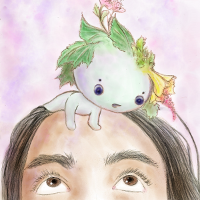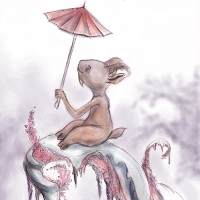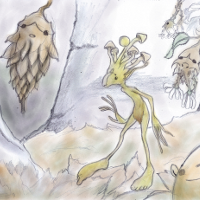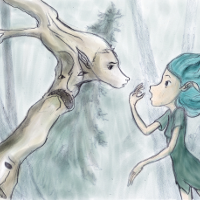 |
Information and stories on Japanese Gods
.
 |
|
Kami Fairy Tales Home Fairies Celtic Fairies Fairy Blog Finno-Baltic-Siberian Fairies Slavic Fairies
|
Japanese Fairy tales Oni Tengu Kitsune Tanuki  Mountain Kami Jagged spires rise from the ocean and forests, up nto the heavens where they bridge the gap between heaven and earth, between pure and impure. For it is from the mountains, from this avenue between heaven and earth that water springs, and it is pure water which brings life to the world. This water comes down from the mountains in the form of springs, and glacial streams. In ancient times the fishermen believed that the mountain kami who controlled navigation and weather lived in the mountains. Further there are a number of folktales in Japan in which the Thunder Kami which brings rain lives within the mountains. Indeed it was believed that since the rain and springs of water came from the mountains, these were the source of life within Japan, the source of agriculture. The terms Yama-no-kami (kami of the mountain) and Ta-No-Kami (Kami of the rice paddy) were interchangeable. So in order to insure an abundant crop the farmers had to entice the kami down from the mountains in the spring time. Rituals and festivals are often designed around this concept, that the people needed to draw the kami from some distance to the village, to welcome the kami when they came down out of the mountains and to please the kami so that they will remain in the area through until harvest time. Once the harvest season was over the kami would then return to the mountains where s/he would live through the winter, until spring time when people would try to entice them down from the mountains again. Of course it wasn’t enough simply to try to draw the mountain kami down out of the mountains in spring time, nearly every high mountain needed to have its own shrine. Many mountain tops had an iwasaka for religious purposes. In front of the shrine on Mt. Atago there’s a large stone with the word ‘kami’ carved into it to let people know where the mountain kami appears. Similar stones are to be found along side the roads, and at the entrances to villages in order to let people know where they might pay respect to the kami. Rocks are a favorite abode of the kami. During festivals small rocks might be possessed and grow very heavy because of the kami within them. When a kami hears a prayer they will make a stone heavier should. Many objects were possessed of kami though some were more reiteki (spiritual) than others and so could take in the kami more easily. When an object was possessed by a kami it became the kami’s residence for a time. When this happened the object in question was at times called kura. Long thin objects make good vessels, thus wands, staffs and trees are common objects for a kami to enter. Pine trees which stand straight and tall are often used for kami to descend from the mountains, the heavens or from other locations. Vessels known as goshintai could be the home of a kami for a much longer time. These could include swords and mirrors. They might also live within a camphor tree of a massive size or ancient age. Twisted and interesting looking trees or beautiful objects. What Mountain Kami are I’ve found that one of the most difficult concepts for people to understand is that there is no one set tradition for what mountain kami are. Rather there are many beliefs about the way mountain kami look and their personality. Even so there are some common beliefs which hold true for many mountains. The most common of these is that the mountain is the causer of birth and rebirth, that it is the mountain from which humans, animals and plants spring. For this reason most mountain kami are portrayed as female. Though many mountain kami are depicted as beautiful some are depicted as ugly hag like creatures. Such mountain kami typically played an important role within a village, for they were the guardian of the people, but also the people’s ruler in some ways. For it was the mountain kami who gave people permission to build new buildings. In some rural area’s of Japan it was believed that the mountain kami would give birth to twelve children which symbolized the months of the year. Mountain kami were often believed to have children who would hunt on the mountain side with their dogs. Hunting is another important role of the mounta in kami with traditions likely going back to ancient Japan when it was hunters who first came to the islands, possibly from the Altai mountains and later from Korea. Mountain kami would have been worshipped by ancient hunting tribes, before they were worshiped by farmers. There is some evidence that the first leaders which were likely shamans and magicians among the hunting tribes explored the mountains. To this day mountains can be an important place for religious study, where mysteries are performed, enlightenment is gained, and where people have the ability to gain magical powers and martial prowess. A girl in the Tono district was given some leaves by tall red faced man (in the Tono district kami appear with red faces) and from this she gained the power of divination. (In Japan shamans, which gained their power from various kami and other spiritual beings, were most often female) It was commonly believed that people gained the power of divination from mountain kami who possessed them. At first such possessed people would go mad, but eventually they would go into a trance. After a time these people would go into the mountains to learn the mystical arts from the mountain kami. Gaining the powers of divination and mind reading, among other things. Sometimes mountain kami ask human hunters for help. The kami of mount Nikko was being attacked by the kami of Mount Akagi. So she asked a hunter to help her. The hunter then went forth and shot out the eyes of the Kami of Mount Akagi who had taken the form of a giant centipede. (It should be noted that the centipede is often times used as a symbol of impurity, of corruption) Disagreements between the kami of the mountains wasn’t necessarily uncommon. In one folktale the kami of Mount Fugi and the Kami of Yatsu-ga-take competed to see who was taller. When it was found that Yatsu-ga-take was taller the kami of Fugi hit the mountain breaking off its top. Kami often test hunters. In one case two hunters came across a young maiden who seemed helpless for she had just given birth and was begging them for food. One of the hunters ignored her pleas for he was worried about the impurity of blood. The other hunter (Koma) offered her his own lunch. Having passed her test the maiden who was really Yama-no-Shinbo (the Divine Mother of the Mountain) promised that the hunter would find success and happiness. Of course blood was considered impure, thus women were restricted from certain mountain rituals lest they bleed during them. While some kami might be born in mountains they also seem to have traveled to some of them. A long time ago a female kami came to Tono with her three daughters and told them that she would give to the one who had the finest dream the best mountain to be their home. During the night a lotus flower floated down from heaven and landed on the bossom of the eldest of the sisters, but the youngest of them saw this and took the flower for herself so that she was able to have the finest dream and get the best mountain. In the Tono region kami are depicted as being tall, at times giants with red faces and radiant eyes. Such kami can be both male and female. One man disturbed a pair of these red faced mountain kami and so was cursed such that he wasted away and died. Mountain kami could be very dangerous in addition to being helpful and so at times people feared encountering them. In addition to their most important tutelary kami people believed that the spirits of the dead went into the mountains to dwell. Thus certain caves and valleys might be believed to be the places where the spirits of the dead dwelled. Ancestral spirits might also live in the mountains then, where they could look down on their decedents to see what they were doing. These ancestors would also come down out of the mountains to receive homage and to help their decedents. |
|





